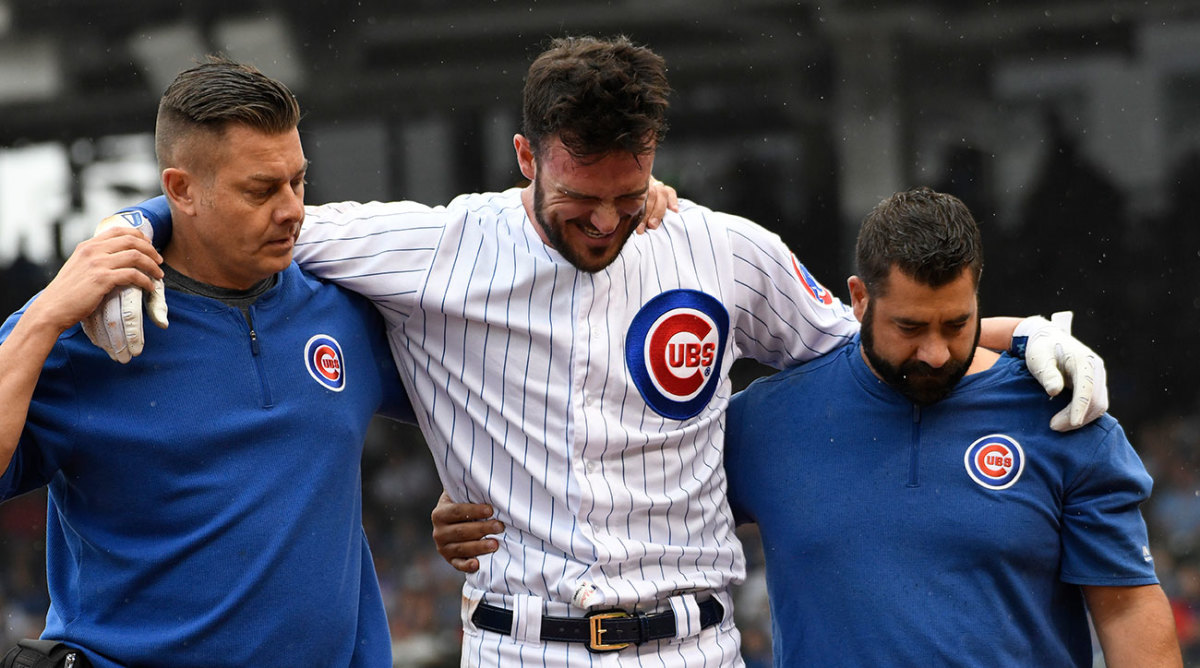'How Many MVPs Have to Go Down?': Scott Boras Is Fed Up With MLB's Unsafe Bases

The hard, slick bases used by Major League Baseball have taken out another star player, and agent Scott Boras is fed up.
“How many MVPs have to go down?” Boras said Monday after Kris Bryant, one his clients and the 2016 NL MVP, slipped on a wet base Sunday at Wrigley Field and sprained his right ankle, effectively ending his season. In 2017 Bryce Harper, another Boras client, was on his way to his second MVP when he injured a knee by also slipping on a wet base.
“We are in between Collective Bargaining Agreements,” Boras said. “The office of the commissioner has the authority to legislate matters of the game relating to weather … We were put on notice about this issue years ago. Where is the protocol for it? It borders on negligence. They did nothing. Zero.”
Major League Baseball does have protocols about the condition of the playing field in bad weather–umpires determine if the field is safe and can order grounds crew to attend to a muddy mound, for instance–but nothing specific about the integrity of the bases, such as when rain and/or mud make them slick.
MLB in recent years has reacted swiftly to injuries to Ruben Tejada at second base and Buster Posey at home plate by rewriting sliding rules to make the game safer. It slowly has increased protective netting around the field to better safeguard fans from foul balls. Other sports have reacted to workplace safety issues, whether it be the NBA diligently mopping any drops of sweat on the floor or the NFL redesigning down and distance markers to pose less of a threat to players as they tumble out of bounds.
But in MLB, in both wet and dry weather, players have been suffering non-contact injuries for years simply because the bases are too hard and slick, and nothing has been done to alter the composition of the bases or the protocols for either umpires or grounds crews in wet weather.
Workplace safety in MLB, including the composition of the bases, is a shared responsibility. Representatives from the players association and MLB serve on the league’s joint Safety and Health Advisory Committee. The committee is supposed to monitor and address safety issues as they arise.
A spokesperson for the commissioner’s office said injuries caused by bases have happened “infrequently” and that no one has presented a better solution than the base in use today.
The list of players seriously injured by bases in just the past few years is lengthy–and predates the current CBA that began in 2017. Among star players who suffered broken thumbs, torn thumb ligaments or serious knee injuries because of bases are Manny Machado (2013), Dustin Pedroia (2013), Harper (2014 and 2017), Ryan Zimmerman (2014), Josh Hamilton (2014), Yadier Molina (2014), Mike Trout (2017), Carlos Correa (2017), George Springer (2018), Trevor Story (2016 and 2019), Javier Baez (2019), Kevin Kiermaier (2019) and now Bryant (2019).
“I’ve got a player who can’t play at the end of the season,” Boras said of Bryant. “How does that affect his team? How does that affect his salary going forward? The potential impact is enormous. And why? Why is there still no protocol?”
Bases are made of steel stanchions and are covered in hard rubber. The hard rubber is designed to “withstand adverse weather conditions,” but more from a durability standpoint than a tactile one. The hard rubber, despite a pebbled surface, gets slick when wet. Bases originally were made of canvas and filled with sawdust or sand–thus the term “bags.” As far back as 2014, then Orioles manager Buck Showalter said baseball “would be better off going [back] to burlap bags.”



































